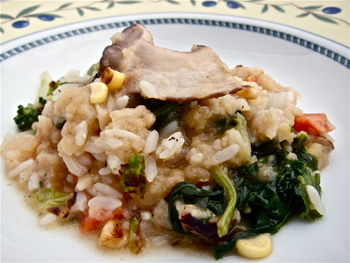 Congee is rice served "wet" in a broth with vegetables, tofu, meat, seafood, or poultry.
Congee is rice served "wet" in a broth with vegetables, tofu, meat, seafood, or poultry.
Congee is the Asian equivalent of Jewish chicken soup, perfect when the weather is cold and damp or you're fighting off a cold. Served in a variety of ways, depending on the country of origin or what's in season, the basic dish is made with cooked rice, a liquid, and flavorings. You'll find dozens of authentic, regional recipes in cookbooks and online, but in our kitchen "congee" is another way of saying repurposed deliciousness.
Whatever we don't eat at a Japanese, Chinese, Vietnamese, or Thai restaurant we bring home. Invariably, a container of rice is included along with the kung pao chicken, tempera shrimp and vegetables, stir fried beef with broccoli, or sweet and sour pork that we couldn't finish.
Reheating these dishes at home is one option, but transforming them into congee is better. For example, converting vegetable and shrimp tempura into an aromatic, deeply satisfying and delicious congee is one way this simple technique can turn left-overs into the best comfort food you've ever eaten.
Tempura Vegetable and Shrimp Congee
Serves 2
Time 30 minutes
Ingredients
2 tempura shrimp, tail removed
4-6 pieces tempura vegetables
1 cup cooked rice
1 garlic clove, skin removed, finely chopped
4 cups spinach leaves, washed to remove grit, stems and leaves finely chopped
4 shiitake mushrooms, washed, tips of the stems removed, thinly sliced
1/2 cup corn kernels, fresh or from a can
2 cups water or miso soup or a combination of both
1 tablespoon olive or sesame oil
Sea salt and pepper to taste
Method
Cut the shrimp and tempura vegetables into bite-sized pieces and set aside. Saute on a medium-low flame the garlic, shiitake mushrooms, and corn kernels until lightly browned.
Add the cut up spinach and water or a mix of miso soup and water. Raise the flame and simmer 10 minutes.
Add the cut up tempura vegetables and shrimp to the broth. Stir well and simmer 10 minutes.
Add the cooked rice, stir well and simmer a final 5 minutes.
David Latt is an Emmy-award winning television producer who turns to cooking to alleviate stress. He shares his experiences with food and his favorite recipes on his blog Men Who Like To Cook.
 My love affair with food began in the dim dark ages of the glorious 1990’s, when neon was king and it was cool to rock a mullet while listening to Marky Mark and his Funky Bunch. Born in San Diego and being brought up by a Hawaiian family from beautiful Kaneohe, greatly impacted my palate, and brought me to the culinary forefront well before my time.
My love affair with food began in the dim dark ages of the glorious 1990’s, when neon was king and it was cool to rock a mullet while listening to Marky Mark and his Funky Bunch. Born in San Diego and being brought up by a Hawaiian family from beautiful Kaneohe, greatly impacted my palate, and brought me to the culinary forefront well before my time.
 My improvisational style of cooking involves templates. Especially when it comes to cold noodles. I hate thinking of them as “salads” since that implies a “dressing” that is at the forefront. Instead, they’re bowls of cool freshness, or fresh coolness. When it’s hot I want a flavor bomb, some spice and not a lot of fat. That fat part? Speaking not from a diet perspective but from a mouth feel. Hot weather eating cries out for something clean, with a defined flavor profile. Not sludgy. So I tend to look toward Asia for flavor influence.
My improvisational style of cooking involves templates. Especially when it comes to cold noodles. I hate thinking of them as “salads” since that implies a “dressing” that is at the forefront. Instead, they’re bowls of cool freshness, or fresh coolness. When it’s hot I want a flavor bomb, some spice and not a lot of fat. That fat part? Speaking not from a diet perspective but from a mouth feel. Hot weather eating cries out for something clean, with a defined flavor profile. Not sludgy. So I tend to look toward Asia for flavor influence. I don’t want to lose weight, stand in line at the gym, or make short-lived resolutions for 2014 - I resolve to live in the moment.
I don’t want to lose weight, stand in line at the gym, or make short-lived resolutions for 2014 - I resolve to live in the moment. I cannot go to a Thai restaurant without ordering green curry. It is by far my most favorite Thai dish and I've eaten so many versions that I can almost say I'm an expert in its flavor. Something about the creamy coconut sauce with slight sweetness, the hot chiles, the green color, and verdant flavor makes me crave this dish very often. Curry, a generic term for dishes in South Asian cuisine, is known for its use of distinctive spices combined to form unique flavor. Most Westerners assume that curry is a single spice or a mixture of them. Although this is somewhat true, the word
I cannot go to a Thai restaurant without ordering green curry. It is by far my most favorite Thai dish and I've eaten so many versions that I can almost say I'm an expert in its flavor. Something about the creamy coconut sauce with slight sweetness, the hot chiles, the green color, and verdant flavor makes me crave this dish very often. Curry, a generic term for dishes in South Asian cuisine, is known for its use of distinctive spices combined to form unique flavor. Most Westerners assume that curry is a single spice or a mixture of them. Although this is somewhat true, the word  Congee is rice served "wet" in a broth with vegetables, tofu, meat, seafood, or poultry.
Congee is rice served "wet" in a broth with vegetables, tofu, meat, seafood, or poultry.